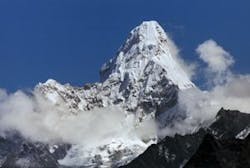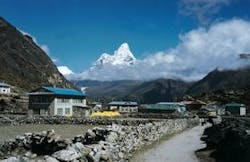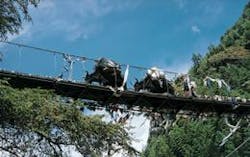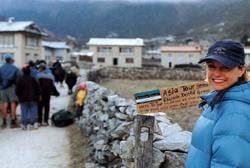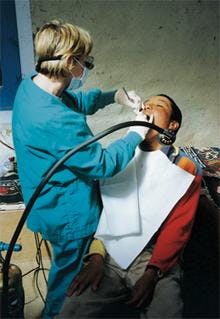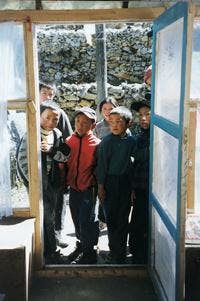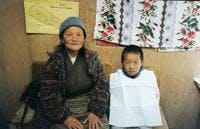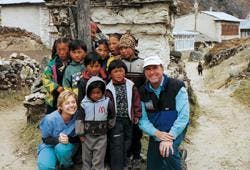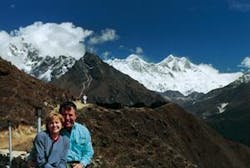Dentistry at the Rooftop of the World
by Heidi A. Baier, RDH
It was more adventure than I ever imagined. Last fall, I joined 10 other volunteers on a trip halfway around the world to work at a dental camp at 13,500 feet in the Everest region of Nepal.
The group included five dentists, two hygienists, and three nonmedical workers. We were led by Global Humanitarian Expeditions, a nonprofit organization that offers humanitarian service tours to remote parts of the world. The group's founder and president, Kimberly Balazs, joined us for our adventure to the rooftop of the world.
Our journey begins with a dazzling flight from the capital city of Kathmandu deep into the highest mountains in the world. As we fly, we see mountain villages and lush foothills terraced for farming. Gradually, the landscape changes as massive, white-capped mountains appear through the clouds and we see our destination — the inch-long landing strip against a steep mountain slope in the village of Lukla. This airstrip is the closest entry point for trekkers traveling to the Everest region of Nepal.
After landing, we meet our sirdar (or guide) Ang Nima Sherpa, and his Sherpa crew. After greeting us, they load our luggage and 12 bags of dental equipment onto the backs of waiting dzos. Dzos are the domesticated version of wild yaks, bull-like creatures with flowing black hair and cruelly pointed horns. In the course of trekking, we learn to give dzos a wide berth. These creatures always get the right of way on narrow trails and cable bridges!
The dental camp is three days' walk from Lukla and an elevation gain of 4,500 feet. This, we learn, is misleading as the trail dips to make every river crossing and rises to reach ridge-top villages. Our trekking days are long but thrilling. We walk along turquoise rivers churning with glacial silt and in the shadow of massive peaks. On the second day, we see Ama Dablam, often called the world's most beautiful peak for its graceful summit. We even glimpse the distinctive, pyramid shape of Mount Everest in the distance.
Each day seems to make us stronger and more confident. But late afternoon still brings a collective sigh when we spot the evening's destination, a cluster of yellow mounded tents at the side of the trail. We spend evenings nursing sore feet, eating lots of food, and sharing in the camaraderie of fellow travelers around a fire.
We reach our destination on the third day when we crest a steep ridge and see the twin Sherpa villages of Khunde and Khumjung below us. To our left, we make out the location of our dental camp — the Khumjung school. Built and funded by the Sir Edmund Hillary Foundation, the school provides education to more than 500 children in nearby villages.
In Khumjung, we meet Laurie Matthews, project director of the Himalayan Dental Relief Project and organizer of our dental camp. Matthews and her dentist-husband, Andrew, founded this nonprofit organization to provide dental care to the children and families of Nepal and surrounding countries in Asia. They work in partnership with Balazs, who organizes groups of volunteers to work in their dental camps.
Laurie and Andrew are from Colorado but are based in Nepal six to eight months a year. There, they organize volunteer dental clinics in charity schools and orphanages in the Kathmandu valley and in schools in the remote villages of Nepal and India. In alliance with volunteers from Global Humanitarian Expeditions, they bring dental care to more than 2,500 children each year.
Our first clinic begins on a windy morning. As we walk to the clinic, we see the schoolyard filling with children accompanied by a parent or grandparent. School is out for the month-long Desain holiday, an exotic and colorful sight, so many of these groups walked two to five hours to reach the clinic today. A teacher devises a system for signing up and keeping track of patients.
The dental camp is limited to the treatment of children, because we reach many of them in the time it takes to treat one adult with no previous dental care. The last few days, however, we hope to open the clinic to senior citizens and those in acute pain, and, of course, we plan to treat our wonderful Sherpa crew and volunteer teachers.
This morning, we join several new volunteers at the clinic. Dr. Tom Grams, a dentist from Colorado, helps us prepare treatment plans for patients as we adapt to our new surroundings. He tells us to do as much work as possible on each child, because it may be his or her only access to dental care until our group returns in the future.
We also meet Bimal and Rochak, two Nepali-trained dental assistants who prove invaluable over the coming days, and Raju, a 16-year-old orphan from Kathmandu who is fascinated with dentistry and assists in Mathews' clinics whenever classes let out. Since our trip is during school holidays, Raju joins us for the trip of his lifetime. His impish sense of humor quickly makes him a favorite.
The dental camp is set in the school's geography classroom and on the auditorium stage next door. We use beds from the school dormitory for patients. Dental workers sit on wooden stools, while mobile dental units, instruments, and supplies perch on desks covered in dental bibs.
The clinic contains many modern conveniences. Each dentist has a portable unit to perform amalgam restorations. Two units have venturi suction, but the rest are served by spit buckets tucked next to the bed. The two rooms have an amalgamator and a set of surgical instruments for extractions. One lucky dentist has a headlight similar to those used in the most modern dental offices back home. The rest use hook-necked halogen lamps or, during the regular power failures, camping headlamps.
The clinics lack amenities we are used to in the United States. The toilet is in an outhouse behind the building. With no running water, we wash our hands using buckets with spigots and a basin below. We sterilize instruments in pressure cookers boiled over propane stoves in the schoolyard, tended by the loyal Sherpa crew.
Hygienists have one Cavitron to use on buildup in patients who have never seen a dentist. It operates with compressed air from a tank manually pumped by the Sherpa crew. The hygienists are the most popular visitors. Everyone — especially young bachelors — wants his teeth cleaned for the first time!
The days pass in a blur — a mixture of exhilaration and hard work. We see as many patients as possible each day — prioritizing those who need cleanings — with many more pressing at the door or peering in the windows. We fill and extract teeth, and spend time talking about oral health and the causes of decay. Each child receives a toothbrush donated by Colgate, along with instructions.
The children are the true highlight. They peek into the clinic to see the high-tech, glittering equipment and the masked, important-looking dentists and hygienists. Their mouths open in big grins from the moment their names are called.
Afterwards, they are the center of attention as friends gather to discuss their experiences and, mostly, their injections. We are in awe of these children who accept injections and dental work with big smiles and murmured thank yous.
Every day brings unexpected challenges. On the second day, we split into teams and go to the village of Thami, two hours away. The hospital staff and teachers tell us we can reach another group of children who live beyond this village. We divide our equipment and supplies and send Dr. Frank Grimaldi and his team down the trail.
The same day, the power fails and work is limited to cleanings and extractions in the soft glow of battery lamps. Patients stack up, and we are anxious to get back to work. Once the power is reinstated, we discover that it is too weak to support power handpieces on the dental units. Frustrated, we decide to move part of the clinic to a new location, spreading the demand on the power grid. This solution seems to work most of the time.
Our annex clinic, as we fondly call it, is in the home of a school parent who is also the town electrician. I get the best location of all — the hygiene station is set in a sunroom surrounded by windows, where patients gather to watch and comment on my work! The bright sun lifts the chill of the unheated room, and the smiling faces of children fill the windows as they peer in. Above their heads are views of magnificent mountain peaks.
On the rooftop of the world, I am having some of the best days of my life. Our backs are sore, our eyes feel strained, and we dream of hot showers and soft beds. Yet the immediacy of what we are doing and the vibrancy of these tough kids touches each of us deeply. It is wonderful work.
My personal high point is an evening hike we take to view the golden glow of sunset on the slopes of Mount Everest. At this incredible spot, my fellow volunteer, Dr. Bill Mulliken, drops to one knee and proposes. I am speechless and teary-eyed as I hug my new fiancée and know that life gets no better!
Our clinic lasts for six days, during which we see 442 patients, fill 298 teeth, extract 144 teeth, and provide 118 cleanings. The volunteer work exceeds $63,000 U.S. dollars.
We worry about the disturbing oral health of the children we see. Many have multiple problems that require extractions and fillings. This unusually high incidence of decay in Napali children seems to result from the many sweets trekkers give them and which are now sold in the village stores.
On our last night, we meet with five members of the school's Parent Committee. With the help of Rochak and Raju as translators, we discuss the need to limit sweets and change the children's diets. Education seems to be the key, and the group is quite receptive.
We brainstorm ideas. Raju volunteers to have students at his school in Kathmandu make posters in Nepali about oral health to display in the Khumjung School. Parents agree to make toothbrushing part of the school activities to encourage compliance.
Volunteer doctors from Khunde Hospital, also operated by the Hillary Foundation, offer to do a school assembly on oral health once the children return to class. Our group of dental volunteers agrees to supply the school with fluoride pills. It is a productive, amazing cross-cultural exchange, and we leave the meeting encouraged and excited.
All great things must end and so does this amazing experience. After six wonderful days in Khumjung, we load up the dzos, say heartfelt goodbyes to our many new friends, and head back down the trail to Lukla and Kathmandu.
As we walk, the children who were our patients wave and shout, "Goodbye, goodbye, goodbye!" Several even say, "Goodbye, Heidi."
It is a bittersweet moment. I will forever remember this adventure in Nepal and the warm smiles of the children of Khumjung!
How you can volunteer ...Global Humanitarian Expeditions is a pending nonprofit organization that sends both nonmedical and dental volunteers abroad to provide humanitarian assistance in Nepal, India, Vietnam, Cambodia, and Thailand. Volunteers work in concert with local people to create, implement, and maintain humanitarian projects in health care, education, and community empowerment for the purpose of preserving and facilitating autonomy and improved quality of life of indigenous peoples. For information about how to volunteer for a dental project in Nepal or India with The Himalayan Dental Relief Project, contact Global Humanitarian Expeditions, 9888 E. Vassar Drive Suite H-210, Denver, Colorado 80231, phone (800) 543-1171, fax (303) 649-9017, email [email protected], or visit humanitariantours.com.
The Himalayan Dental Relief Project (HDRP) is a nonprofit organization dedicated to providing first-time dental care to the neediest children and families of Nepal and surrounding countries. HDRP offers both individual and custom volunteer experiences in Nepal and group dental camps in partnership with Global Humanitarian Tours. Please consider a donation to support this important work. Donations are tax-deductible and used to provide direct care to those most in need. Equipment and dental supplies are also urgently needed. For more information, contact Himalayan Dental Relief, 2091 Birch St., Denver, CO 80207, phone (303) 393-7284, email [email protected], or visit himalayandental.com.
Heidi A. Baier, RDH, practices dental hygiene in Mill Creek, Wash. She has a bachelor's degree in communications with a minor in psychology from Washington State University. In 1997, she received an associate's degree in dental hygiene. Ms. Baier serves on the board for Global Humanitarian Expeditions.
